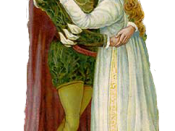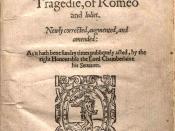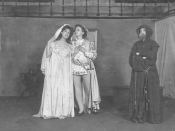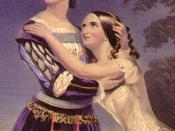Shakespeare adaptation is a big time business. From modern retellings to direct versions of movies, plays etc. In his book Big Time Shakespeare, Michael Bristol states that Shakespeare is ÃÂprofitable in the context of commercial film productionÃÂ because ÃÂShakespeare's works are a progress of human civilizationÃÂ (8). Perhaps we can point to this showing of human progress as how Shakespeare has lived for centuries past his physical death. But what this means is that Shakespeare is presenting us with a picture or snapshot of human interaction that results in progress. This is an important thing to note when talking about Shakespeare adaptation because it is that quality that makes Shakespeare so adaptable; if he writes about progress in the most general sense, then we should be able to update it and show the same progress in a more relevant time. These adaptations are possible, says Bristol, because Shakespeare did not write his plays as ÃÂclosed discursive formations nor are they limited to expressing the concerns and interests of a narrowly circumscribed historical period.
They have potential for generating new meaningsÃÂ (11). The potential for generating new meanings comes from the interpretation that comes with adapting a play. When a play gets updated for adaptation, the meaning usually stays the same, itÃÂs the presentation thatÃÂs different.
Struck by the adolescent feeling in the Romeo and Juliet, Jerome Robbins began thinking about how he might adapt the role of Romeo to make it seem less passive. He soon began to see that in order to adapt the story, he needed to bring the emotional violence of Romeo and Juliet into the world he was in; the world of 1949. A long way down the road, the adaptation team noticed a newspaper article that talked about Mexican immigrants getting into gang fights with supposedly true Americans. At this point it was like a light clicked on and they decided to move the setting to West New York and have the two noble houses be gangs of Puerto Ricans and Americans. Thus in 1957 the show debuted on Broadway and an astounding 4 years later was turned into a movie.
The endings of the dramas are clearly different, yet the themes of the original story are clearly present. Love knowing no boundaries is an obvious theme displayed by the love between two people who, according to social conventions, should not interact at all. Then the theme of the individual versus their society or niche is depicted by various characters in both stories when they attempt to convince the lovers to stick to what they know.
Juliet commits suicide when she learns that Romeo would rather die than live without her. But Maria makes a different choice, despite threatening to kill herself. But her love for Tony leads her to force social change by staying alive, as a reminder of this heartbreak that connects both the Sharks and the Jets. This is the fundamental difference. Maria forces social change by being a constant reminder of what ties both gangs together, whereas the death of Romeo and Juliet forces nothing because it is final. Nothing is left of them or their love in the world except memories which are not objective enough to force social change, merely suggest it.
Because of her decision, Maria makes an interesting flip and mirrors the Prince in Romeo and Juliet. Maria becomes the authority at the end of the musical by becoming the driving force of social change and because she commands respect in the way she conducts herself after her lover dies in her arms. Essentially both Maria and the Prince attempt to change the two feuding sides by saying ÃÂlook what youÃÂve done. We are all punished because we all have to live with what weÃÂve caused.àLines 292 à295 of Romeo and Juliet express the PrinceÃÂs disgust of the situation and what caused it: ÃÂSee what a scourge is laid upon your hate? / That heaven finds means to kill your joys with love. / And I, for winking at your discords, too / Have lost a brace of a kinsmen. All are punished.ÃÂThe stories are basically the same, obviously the plot is very similar but the characters are similar too. Romeo and Tony are both rash and emotional young men while both Juliet and Maria are more logical and strong willed: Romeo and Tony, while overcome by love are swayed easily by anger and kill someone and Juliet and Maria try to help others understand while suppressing their love and pretending to be happy with their circumstances of arranged marriage. In fact, for almost every character in Romeo and Juliet, West Side Story has a counterpart:ÃÂNurse àAnitaÃÂTybalt àBernardoÃÂFriar Lawrence àDocÃÂParis àChinoÃÂMercutio àRiffThe obvious main story change comes from the era in which it was adapted into: the gang era of the 1950ÃÂs. This has come under much scrutiny and criticism for itÃÂs portrayal of Puerto Ricans. In her essay Feeling Pretty: West Side Story and Puerto Rican Identity Discourses Frances Negrón-Muntaner explains how the portrayals of Puerto Rican men as gang members and women as virginal and sassy is detrimental to Puerto Rican society. She says that itÃÂs ironic to present Puerto Ricans in this way yet claim that the film is ÃÂnot in any way "about" Puerto Rican culture, migration, or community life.àWhile this is a popular reading by critics, they are missing the point of the story. The writers wanted to update Romeo and Juliet and the Puerto Rican and American gang riots were a hot topic and the story fit easily in that environment. It wasnÃÂt meant to be a commentary on Puerto Ricans, but a commentary on gang lifestyles while incorporating the plot, characters and themes of ShakespeareÃÂs original story.
Other criticism of the adaptation comes from Shakespeare sticklers who insist that any adaptation isnÃÂt good enough. Carolyn Jess-Cooke claims that, "there has been a tendency in recent films to update and strip down Shakespeare's language, replace the title, boil down the plot and ultimately use the Shakespeare play as a stamp of cultural legitimacy rather than a faithfully-rendered early-modern text" (88). While she makes a valid point regarding attachment to Shakespeare being ÃÂa stamp of cultural legitimacyÃÂ, striping down ShakespeareÃÂs original language but incorporating his original story makes Shakespeare interesting and relevant to the audiences of today.
Jess-Cooke brings an interesting slant to the idea of faithfulness in adaptation which is especially pertinent in this adaptation because unlike Romeo and Juliet, West Side Story is not a tragedy. Shakespeare was intentionally writing a tragedy whereas the West Side Story collaborative team were not so focussed on the tragic aspect, but on making Shakespeare accessible to new audiences and capturing the gang wars as a moment in history. Although West Side Story does include elements typically used in tragedies (many deaths, troubled hero, a heroÃÂs death etc) it cannot be considered a tragedy for two crucial reasons: it was not written to be a tragedy and because human suffering as a result of death is portrayed as being hopeful. While everyone in Romeo and Juliet must suffer because they donÃÂt know or understand the whole story behind the deaths of their loved ones, really only two people in West Side Story suffer: Maria and Anita. We donÃÂt know anything about TonyÃÂs family and because of that we cannot assume their suffering because of his death. Since he severed ties with the Jets prior to the story in the movie, they probably arenÃÂt suffering over his death either. BernardoÃÂs death causes both Anita and Maria to suffer for losing a boyfriend and brother, respectively. And obviously TonyÃÂs death spurs MariaÃÂs suffering even more.
An unhappy ending like the one in Romeo and Juliet leaves the audience feeling different than the sombre one found in West Side Story. I propose that the ending of West Side Story offers less hope, but with more closure whereas the ending of Romeo and Juliet offers more hope but with less closure.
West Side StoryÃÂs ending offers hope when we see the two gangs working together to carry TonyÃÂs body out of the basketball court. But this hope for reconciliation and acceptance is dashed almost instantly when we see other members of the gangs leaving in opposite directions because ÃÂthey are not yet ready, and perhaps never will be ready, to give up war as a way of life.ÃÂ This exit is undeniable since that is what the script insists on.
Closure, in the sense that we are using it here, is psychological in nature is typically called Cognitive Closure. This mean essentially that one achieves a ÃÂcomforting or satisfying sense of finalityÃÂ accompanied with a definite ending and a gaining of knowledge. Maria experiences closure in this sense because she sees TonyÃÂs death as an ending of the gang wars, her way of life as well as her love. And while this might not seem satisfying in the least, it is final and she has accepted that. This is clear when she leaves the scene of her loverÃÂs death with the procession of people who have been changed by the events. She is leaving it in the past, behind her and she is looking to the future where everyone will be treated the same, regardless of country of origin.
In Romeo and Juliet the ending offers much more hope than West Side Story because Montague and Capulet express their emotions and their sadness while also realizing that theyÃÂve been foolish to feud. They both agree to erect statues of the otherÃÂs child as a monument of their burying the hatchet.
But it is this same expression and offering of hope that gives much less closure than its musical counterpart. Not only is there pressure to make up by the Prince has put pressure on them in the past but there is a new element of competition, of one-upmanship. Montague says heÃÂll make a statue honouring Juliet and Capulet replies that the one of Romeo will be far richer. These two speeches are crucial to the idea of closure because it almost appears that the feud takes on meaning now because it was just tradition in the past. Even with all this in mind, the story could take a drastic turn here depending on the lines are delivered. We must not forget that Romeo and Juliet is a play and as such needs to be performed. The actors and director could decide that these lines are to be said in a sarcastic tone which would definitely show a complete lack of closure and lack of realization of the tragedy itself.
Laurents said that this is how the play must end. He wrote it into the script so therefore it has importance. Shakespeare's lack of stage directions leaves the ending up to interpretation by the actors and the director. For example, in the Baz Luhrmann version of Romeo and Juliet, the exchange between the heads of households is completely cut leaving a severe lack of hope AND closure.
"closure." Merriam-Webster Online Dictionary. 2009.
Merriam-Webster Online. 15 September 200914 Sept. 2009 Bradley, Andrew Cecil. Shakespearean Tragedy. London: Macmillan and Co., Ltd, 1908. Bristol, Michael. Big-Time Shakespeare. New York: Routledge, 1996. 16 Sept. 2009 Friedman, Michael D. "Introduction: ''to think o' th' teen that I have turned you to': the scholarly consideration of teen Shakespeare films.'." Shakespeare Bulletin 26.2 (Summer 2008): 1(7). General OneFile. Gale. UNIV OF REGINA. 17 Sept. 2009Garebian, Keith. The Making of West Side Story. Toronto: ECW Press, 1995.
Negrón-Muntaner, Frances. "Feeling Pretty: West Side Story and Puerto Rican Identity Discourses." Social Text, 63 (Summer, 2000), pp. 83-106West Side Story. West Side Story CollectorÃÂs Edition: Santa Monica, 2005.





